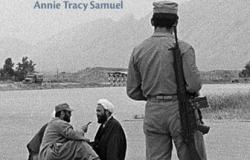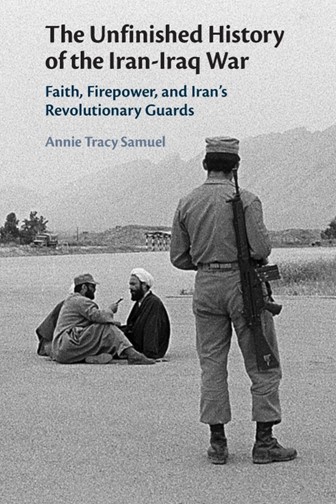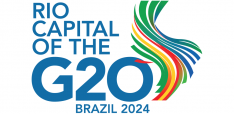Book Review - The Unfinished History of the Iran-Iraq War: Faith, Firepower, and Iran’s Revolutionary Guards

The Unfinished History of the Iran-Iraq War: Faith, Firepower, and Iran’s Revolutionary Guards by Annie Tracy Samuel. Cambridge: Cambridge University Press 2022. 302 pp., £75 hardcover 9781108478427, £22.99 paperback 9781108745789
Annie Tracy Samuel’s The Unfinished History of the Iran-Iraq War fills a gap in the literature on Iran’s military, the Islamic Revolutionary Guard Corps and the Iran-Iraq War, and through analysing its history, the book provides us with insight into Iran’s stance in the international sphere today.
Tracy Samuel provides in-depth coverage of IRGC history, its organisational development during the eight-year long war and by extension the consequences of the Iran-Iraq War on the IRGC’s present role and power in the Islamic Republic. She explores this through the IRGC’s own perspective by paying particular attention to volumes of available material and publications linked with the IRGC’s Holy Defense Research and Documentation Centre (HDRDC), while touching occasionally on other primary Persian sources like press and memoirs, as well as the second-hand English material.
Central to the author’s argument is that the birth of the IRGC and its development reflected pragmatic necessity of the revolution and defense of the country during the Iran-Iraq war and afterwards in its relations with the region and the West. Central to the thrust of her argument is that ideology was important in Iranian defense: that it was not used to inform policy, but to strengthen morale. In sum, the author contends that both ideology and firepower were used by the IRGC, and that the strategy and rationale of the Iranian civil and military decision makers in the war were all the product of pragmatic thinking.
 The book is set out in 12 chapters. The first two chapters introduce the main subject of the book, the Islamic Revolutionary Guards Corps (IRGC) its units, its roles and its historians. Chapter 1 looks at the birth of the IRGC in the early days of the revolution’s history, its domestic security functions to safeguard the new revolutionary regime and serve as a loyal paramilitary organisation in parallel to the regular army, whose loyalty was still doubtful.
The book is set out in 12 chapters. The first two chapters introduce the main subject of the book, the Islamic Revolutionary Guards Corps (IRGC) its units, its roles and its historians. Chapter 1 looks at the birth of the IRGC in the early days of the revolution’s history, its domestic security functions to safeguard the new revolutionary regime and serve as a loyal paramilitary organisation in parallel to the regular army, whose loyalty was still doubtful.
Chapter 2 discusses the history of the IRGC and explains the Iran-Iraq war from the perspective of the IRGC’s own publications, primary sources and oral history. Here, Tracy Samuel makes use of a major work, the Chronology of the Iran-Iraq War, published by one of the IRGC main research centres for study of the Iran-Iraq War, the Holy Defense Research and Documentation Centre (HDRDC), encompassing thousands of documents and material on the Iranian revolution and the Iran-Iraq War from 1979- 1988.
Chapter 3 discusses the outbreak of the war from the perspective of the IRGC historians and authors, and Iranian views on Iraq’s decision to invade Iran. Chapter 4 turns to the early stages of the war. The IRGC sources that Tracy Samuel highlights, point out that while popular forces were resisting and defending the invasion, the IRGC and Iran’s regular military were debilitated by internal conflict evident in the leadership at home as well as lack of cooperation between the IRGC and the regular military.
A turning point in the Iranian forces’ defence is discussed in chapter 5, along with the ousting of Iranian President Abolhassan Banisadr, which according to the IRGC authors brought about more cooperation and cohesion to Iran’s armed forces, while the IRGC’s role in the war was augmented. Iran’s decision to continue to pursue the war by invading Iraq (in 1982) is discussed in chapter 6. Drawing on the IRGC authors and documents, Tracy Samuel maintains that this decision was made via consultation based on the IRGC’s assessment (with Khomeini, the leader of the Islamic Republic, being an arbitrator) of the likelihood of further aggression by Saddam Hussein and Iran’s distrust of his regime and the unwillingness of the United Nation Security Council to recognise him as an aggressor as the Islamic Republic demanded.
Chapter 7 shows that successive operations fell short of producing the desired result for Iran. This was made more difficult by what Tracy Samuel refers to as pluralisation of the war, namely the aerial bombardment of the cities by Iraq using its superior air power, its chemical and psychological warfare against the Iranian forces and the ‘extensive support’ Iraq obtained from third parties, namely the United States following the Tanker War in the Persian Gulf (pp. 160-168).
Chapter 8 discusses Iran’s acceptance of the ceasefire in the summer of 1988 from the perspective of the IRGC. Pressure on the Iranian economy, difficulty to procure weapons and declining morale of the Iranian forces all contributed to this. But it was portrayed as a victory by the IRGC, as Iran did not lose any territory to Iraq. In Chapter 9, against what she sees as literalised reading of the Islamic Republic’s rhetoric and slogans, Tracy Samuel argues that both the Islamic Republic and the IRGC were pragmatic in their war efforts and strategies, drawing both on ideology and firepower.
Chapter 10 turns to political and strategic lessons that the Islamic Republic and the IRGC learnt from Iran-Iraq war, giving rise to its more recent foreign policy relations in the region, and a security doctrine based on asymmetric and soft power, via ties with and support for proxies in the region in order to ensure the protection of Iran and its independence. Chapter 11 looks at the IRGC’s expansion as a professional military as a result of the Iran-Iraq war, its expansion into non-military spheres, particularly countering political threats, and its recent role dealing with the Coronavirus pandemic.
This book is a welcome addition to the literature on the post-revolutionary Iranian politics (from 1979), the IRGC and the Iran-Iraq war, and will be of interest to anybody seeking a better understanding of Iran’s place in the region and the world today. The author’s work is praiseworthy for drawing on the plethora of Persian sources and documents mainly of the IRGC’s Iran-Iraq Chronology of War published a few years after the war. In this regard, Tracy Samuel’s work adds to the literature by highlighting how the Iran-Iraq War has been given meaning to or has been framed by the IRGC, and its historians. The book however suffers from three shortcomings regarding the engagement of the literature and approach to the primary database for the author’s analysis.
First, the author relies extensively on the IRGC publications without a sufficient critical eye. While the use of the IRGC publications in this book is commendable, the author by and large overlooks the likely bias in such sources particularly if one considers how the account of history is written within the authoritarian regimes, like the Islamic Republic, and the possibility of selective use of sources.
Second, there is insufficient engagement with other sources, such as the volumes of memoirs by the late Hashemi Rafsanjani who was the acting Commander of the armed forces and the IRGC at critical stages of the War. This problem leads to a disjointed account of the Iran-Iraq War, where blunders and incompetence of IRGC commanders are completely missed.
Lastly, the author’s treatment of the secondary literature in English is rather cursory, arguing that such works on the IRGC and Iran-Iraq War are riddled with hyperbole about the ideological calls for mobilisation and slogans. The author tends to dilute ideology and merely sees it as an instrument of policy or only as a factor to strengthen the will of the Iranian forces.
What is obfuscated is the path dependent way ideology influenced the regime’s decision-making in terms of what its capacity could allow at the time: for example, the human wave tactics led by the IRGC which bore a heavy cost for the Iranian forces in terms of loss of lives with little decisive gain, and the offensive into Iraq by the Iranian forces despite the balance of power that leaned greatly in favour of Iraq and the pluralisation of the war as discussed by the author in Chapter 7 and Chapter 8 – all of which raises questions about the alleged pragmatism of the Iranian leadership.
Dr. Hesam Forozan received his PhD from Durham University in Middle Eastern Politics with particular focus on the Islamic Revolutionary Guards Corps. He is the author of The Military in Post-Revolutionary Iran: The Evolution and Roles of the Revolutionary Guards (London: Routledge 2016).


